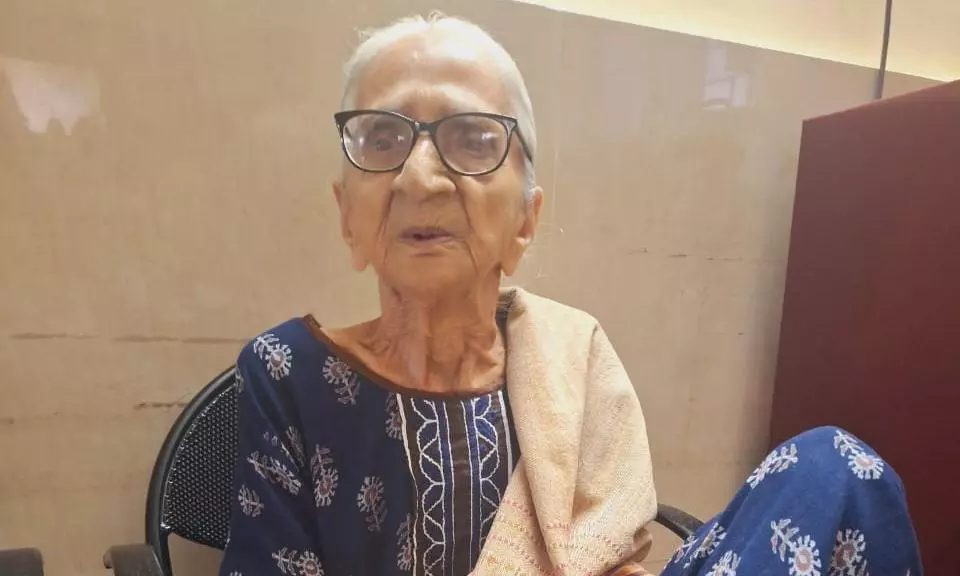
Amid 50-year festivities, forgotten Kannada icon’s widow lives in destitution
Inmates of the old-age home cursed successive governments for not recognizing Kamalamma and her husband’s contributions to the Kannada language

The 97-year-old widow of the man who first designed the Kannada flag now leads a life of anonymity, forgotten by the people even as they celebrate Karnataka’s golden jubilee.
Call it a cruel irony of fate but Kamalamma has been living quietly in an old-age home in Bengaluru for 50 long years, with none to call her own.
After searching for her at Sharada Kuteera, a shelter for the elderly, The Federal located her at the Sevakshetra Hospital where she is being treated for a leg injury.
“I fell down and was injured. The ashram people got me admitted here. The medical staff treat me like their mother,” said the frail-looking Kamalamma, pasting a pale smile on her wrinkled face.
At a time when almost every second Kannadiga, politicians included, is waving the yellow-and-red Kannada flag, the wife of the late Ma Ramamurthy is far away from all the action.
Destitute home
While Ma Ramamurthy himself is a fading memory for the people of Karnataka, it is not surprising that Kamalamma has been forced to spend her last days in a destitute home.
Except for a few, most of those who fought for Karnataka’s land, language, and culture have faded from people’s memory.
It was Ra Nam Chandrashekar, writer of a book on Ma Ramamurthy, who helped The Federal to track down Kamalamma.
The new flag recognised by the Karnataka government in 2018 is inspired by the Kannada flag designed by Ma Ramamurthy. It has the original red and yellow horizontal stripes.
Age has not dimmed Kamalamma’s memories. Ask her about her husband’s flag movement and she narrates a decades-old incident as if it happened only a day ago.
Dravidian flag
“Some people from Tamil Nadu hoisted a Dravidian flag in Akkipete (then dominated by Tamil speakers). This irked my husband and he decided to design a Kannada flag and hoist it at Akkipete,” she said, her gaze fixed on a tall tree through the glass pane of the hospital.
She said her husband and noted writers and Kannada activists like Aa Na Krishnaraya (AaNaKru) and Ta Ra Subbaraya (TaRaSu) discussed the design of the proposed flag.
“My husband took the responsibility of designing it. He did not design it in one day. It took many days, maybe a month or two, to conceptualise it. He went to a weaver and a tailor and customized it. My husband and our two sons used to walk the city almost every day carrying the flag,” Kamalamma recalled proudly.
“Finally, my husband succeeded in hoisting the flag in the Akkipet area.”
Kamalamma said her husband was prepared to sacrifice his life for the cause of Kannada.
Kannada struggle
“He was always at the forefront of Kannada struggles. Our house was always abuzz with Kannada writers. I remember taking part in a few protests with him. People would drop in regardless of time. I would serve them food and tea. This was my service for the Kannada movement,” she said.
Regrettably, Kamalamma was denied an old-age pension. Former chief minister SM Krishna, now in the BJP, urged then chief minister Basavaraj Bommai last year to finally sanction her pension.
Ma Ramamurthy was the son of a noted freedom fighter and litterateur, Veerakesari Seetharama Shastry. Born in Nanjangud near Mysuru, Ma Ramamurthy had his education at Nanjangud and Bengaluru.
Inspired by his father, he participated in the freedom movement. He was a voracious reader and became a writer to reckon with in Kannada.
Considering his contribution to Kannada and leadership in all Kannada related movements, he was popularly referred to as “Kannadada Veera Senani” (Commander of Kannada Movement).
Untimely death
Kamalamma said several police cases were slapped against her husband for taking part in movements to restore Kannada dignity.
“Schism also appeared in the Kannada movement. Disillusioned, he took up farming in Kaggalipura on the city's outskirts. To irrigate, he had a well dug.
“When water gushed out, he and our two sons went to inspect the well. To my misfortune, the earth suddenly caved in. All three were buried alive on December 25, 1967,” said a teary-eyed Kamalamma.
“For some time, people used to invite me to Kannada Rajyotsava organized by Kannada groups. After my husband’s death, I got busy looking after my aged in-laws. Slowly, people have forgotten me,” she added, wiping her tears.
The inmates of Sharada Kuteera, the old age home, are full of praise for Kamalamma’s agile lifestyle even at this age. They blamed successive governments for not recognizing her and Ramamurthy’s contribution to Kannada and Karnataka.
“It appears even the present government suffers from selective amnesia. They are celebrating the golden jubilee of Karnataka on a grand scale without even mentioning the name of Kamalamma and Ramamurthy,” rued an 80-year-old woman inmate, seeking anonymity.

